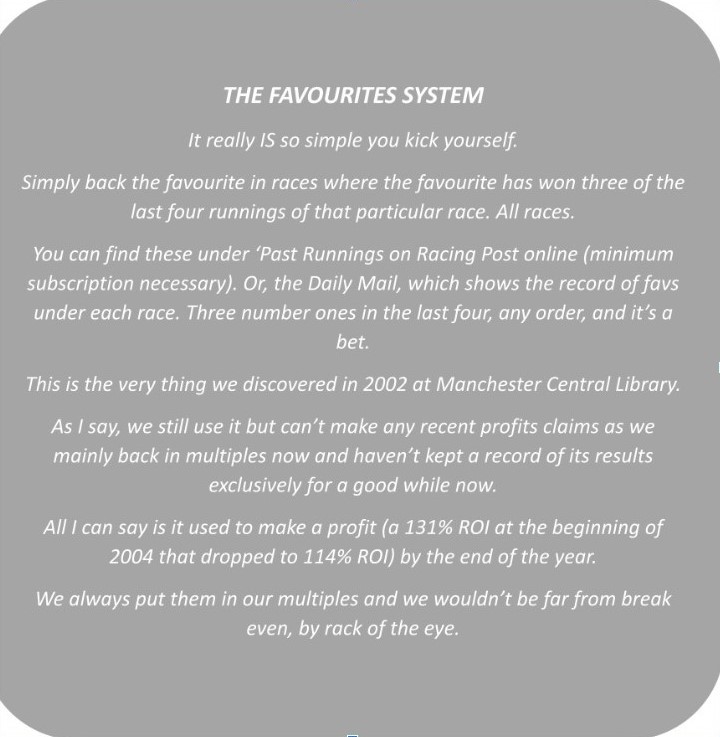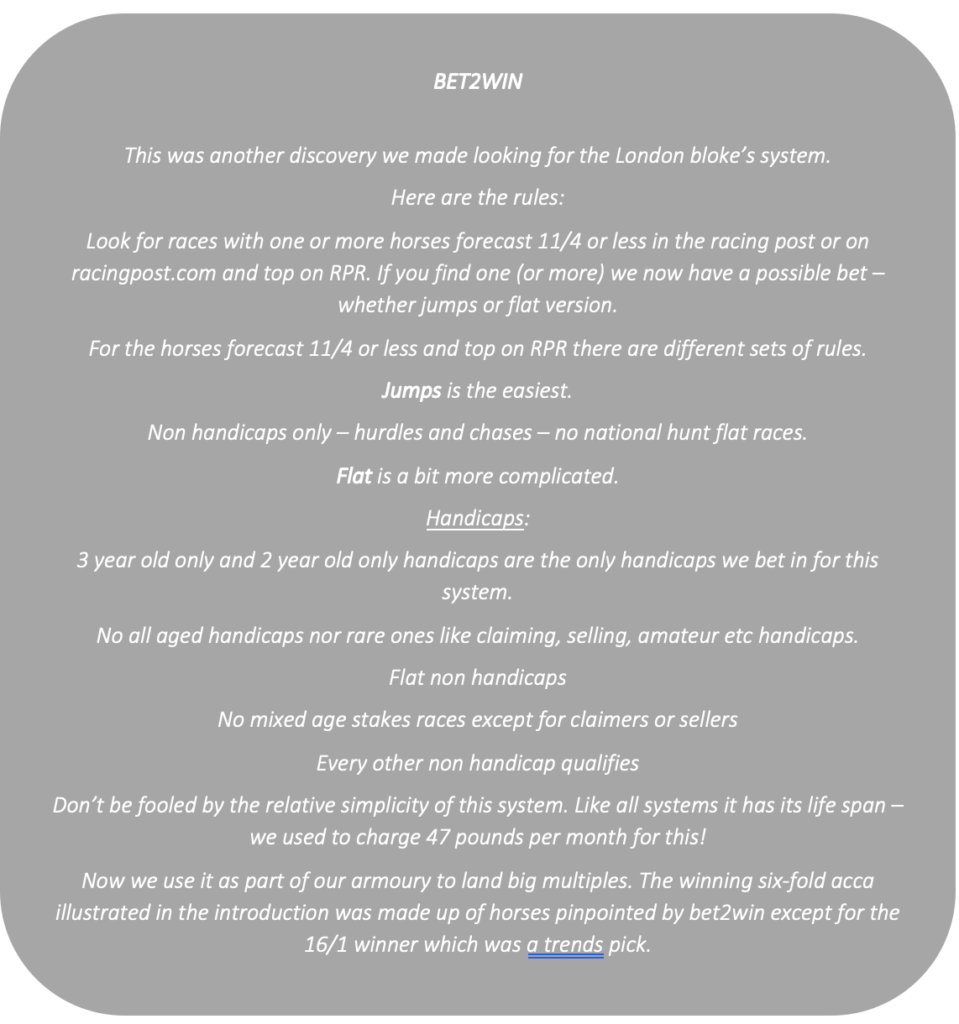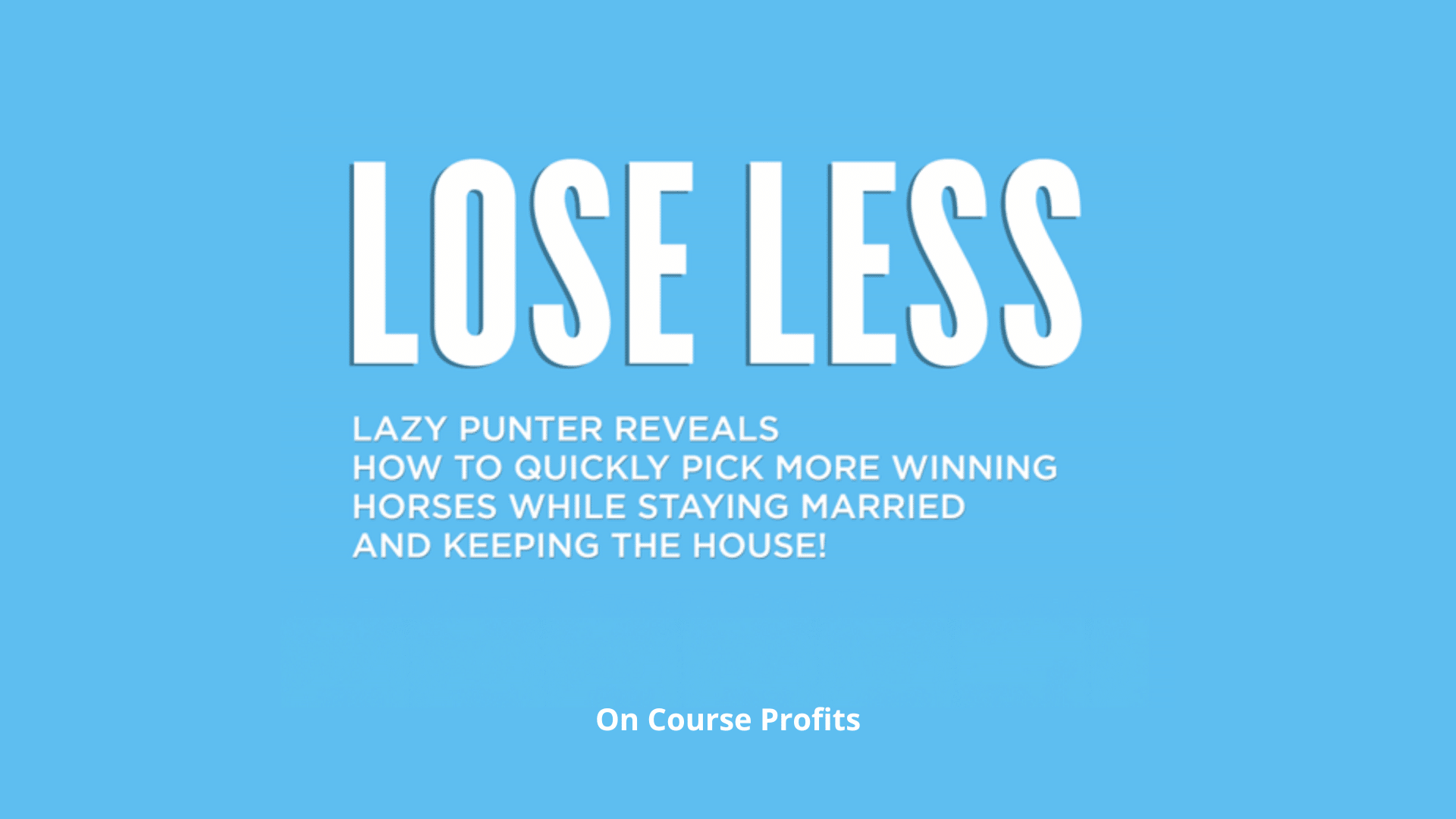Lose Less by John Cutts – Part III
Our next instalment of Lose Less kindly provided by the author, John Cutts.
Early reviews for the book have been very positive with an overall 4 star rating as I type.
If you can’t wait for 12 months you can get it in paperback or on Kindle here
Chapter 3 – The First Fruits Are Borne
Before that though, some acknowledgements to the inspiration for all our research since those days, the London bloke, and then of course Eric from whom we learned so much about maths, especially probability.
Eric pointed us to a book by Tony Drapkin and Richard Forsyth called The Punter’s Revenge (1987) which was ground-breaking for its time in terms of using computers as a guide to gambling.
Then of course, DFL software who again broke new ground with their Compunter and Combayes computer selection processes.
These were an inspiration, no doubt, to the next generation at Racing Systems Builder (RSB) who came up with their seminal database and system builder of the same name, which, in my opinion, is unsurpassed to this day – and they started in 1985!
The Racing Post which is quite simply indispensable for the serious backer. If you don’t believe me, try and get a serious bet on Betfair before RacingPostOnline puts up its betting forecasts!
Finally, since around 2010, when Racing System Builder closed, we have been using a site called HorseRaceBase for its system builder, amongst many other things. This has been a boon since the closure of RSB, closely followed by Adrian Massey upping sticks.
All these resources have helped us over the years. Not to discover the London Bloke’s system (so far!) but to discover profitable betting strategies hopefully en route to its discovery.
After the London BIoke stopped, I was inclined to walk away. We had missed the boat. If only we had got to know the London bloke a few years earlier. However, Mark was spurred on to find out more, and, to his great credit, his perseverance paid off.
He analysed the list of the London Bloke’s selections to see just what the London Bloke had meant when he said the selection is “the best horse in the race “.
You must remember that in those days – as we had not yet appreciated the full majesty of Racing Systems Builder – research meant thumbing through back issues of the Racing Post.
Anyway, he identified a few fundamental factors that would consistently produce the same selections as were on the London Bloke’s selections list, but they were among several other horses.
There were rarely more than 2 or 3 selections per day. However, this achieved a strike rate of 48% at just short of break even at SP. We were onto something, but more research was needed.
Bear in mind we were now working full time in the Glazing business, so this process took place over several years. In between we would try and get an edge through vetting the selections on form, trainer stats etc and/or taking prices. The latter being revolutionised when Betfair set up in June 2000.
So, we had the basic ingredients but there were obviously more filters we had missed.
We had always wondered why he should mention that he bought the Daily Mail every day. So, one day in 2002 Mark and I spent a full day in Manchester Central Library looking through back issues, on microfiche, of the Daily Mail.
Here we made a breakthrough. We found a factor that increased the strike rate by 30%!
It took the strike rate up from 48% to 63% at an average SP of 11/10. Not quite “Eureka” as we had not achieved the 80% strike rate of its heyday and there were still some discrepancies – but far less!
This new system achieved a 131% return on investment.
This opened a new phase when we set up a new service call Percentage Betting to offer the selections from the system online to the general betting public over the Christmas holidays in 2003.
We were at the top of most search engines through the pay per click advertising medium of Google AdWords at that time. Plus, of course, backing them too. We were making a decent wage but not life changing amounts of money
Then we had a huge setback. In April 2004, the US government banned Google from facilitating the advertising of anything relating to internet gambling (I note the bookies ads are still up though!). So we had to change to full page ads in the Racing Post, Raceform Update, Racing & Football Outlook etc to promote the service.
These are not cheap and seriously dented our profits. We had a loyal clientele behind us however, and they got us through 2004 but we hit a bad run in November 2004 and ended up winding up the site by Christmas, a year after we started.
The system rarely performed up to the level it had previously achieved. There were some 8 winning months and 4 losing to level stakes at SP. The annual analysis showed a strike rate of 55% at 2.08, an ROI of ‘only’ 114.4%. Not to be sneezed at but disappointing by comparison with the past. We still use this system.
When used with the Bet2Win System (next chapter) it provided the breakthrough referred to above – 63% strike rate at 131% ROI.

Chapter 4 – The Big Breakthrough – Bet2Win is born
Having learned some lessons about blind copying of existing systems, the fact that even the best systems have a shelf life and the tendency for fluctuation – which means that both winners and losers can cluster in quite unanticipated ways – we have spent the ensuing years researching, backing and perfecting what we learned in our search for the 80% system of the London Bloke.
2004 was the year we took a greater interest in Racing Systems Builder.
We had a free copy (they used to send a CD with 2 years of data as a trial) which we had never really taken the trouble to get to know. We finally saved up and bought the 2 discs, one for jumps the other for flat.
These were an invaluable aid to testing all sorts of theories and a much quicker way to back-check systems (it is amazing how you start using something more often once you have paid good money for it!).
Through applying the lessons learned from our search for the London bloke’s system and the knowledge we had acquired in so doing, plus the ability to instantly back-check any theories we might have – we have a flat disc that goes back to 1986–2009! – we have been able to develop our approach.
- Back horses that are the product of systems and methods that have a logical basis and have been checked in sufficient numbers and over a sufficient period to prove their worth.
This was the lesson that led us to the BET2WIN SYSTEM and the Favourites System.
- Turn your money over – use leverage. That is how the bookies bet and who better to copy than the most consistently successful?
All systems can be improved in terms of achieving a higher percentage strike rate and/or percentage ROI but this always means less selections.
Which means a much-reduced turnover. So, we have, at the average win rate of 40%, a preference for higher turnover.
Basically, money makes money and the only way the small punter has a chance of big pay days is by backing lots of horses either in singles or multiples which leverage your small starting stake. You should have a bank, as I will discuss later, but, if you haven’t you can still cover small stakes multiples if it is money you can afford to lose.
I generally back an acca to one pound unit stakes.
On a Saturday or the festivals, I will cover the doubles too.
But if you can only afford 25p stakes you will still have plenty of fun finding plenty of winners that you sometimes catch in clusters for big pay-outs.
Failing that, the systems and methods I show you in this book will be useful for the ITV7 which is free and can win you 50K+.
I should do the usual sensible betting lecture here, but you are a grown up and, even just a quid acca on a Saturday isn’t going to put you on skid row!
Besides, lots of people do the lottery and Euro Millions which offer little, if any, fun at all.
- Use Best Odds Guaranteed (B.O.G.).
I know a lot of people play the exchanges and the best of luck to them. But we have found that we get better profits using BOG the night before racing.
BOG is simple. You take the price on the horse and if the SP is bigger, they pay you out at that bigger price.
If, on the other hand, the odds shorten, then you get the benefits of taking the price and get paid at the price taken. We have found this gives us a real edge.
Ok. That’s our biography in as far as it relates to horse racing, our philosophy and betting; the history of our search for the London bloke’s original system; the discovery of it but at a lower performance than originally; lessons learned in the quest to find out that system and, finally, our approach today after 30 years of hard work and experience.
Here are the rules for the filter we discovered at Manchester Library:
When combined with the Favourites System in the last chapter, this achieved the 63% strike rate at 131% ROI that our trip to Manchester library produced.
The bookies seem to have got wind of it but it is still profitable and ideal for bankers in multiple bets.
We have never renounced betting singles, but we are always looking for the big win which, not betting big stakes, means a winning multiple for us.
You can get the selections from our portfolio every ITV racing day – The TV Service.
These will be system bets covered by ITV.

It’s free and you also get the trends and selection for the day’s big race.
These are every Saturday and any other racing covered by ITV such as the Cheltenham Festival, Royal Ascot etc.
We will continue our serialisation next month, if you would like to read the whole book right away you can buy it here



